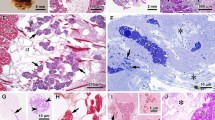Abstract
Observations on sixth-stage nauplius (pre-cyprid) of the barnacle Balanus eberneus Gould treated with L-proline-3,4-H3 suggest that the cement gland in this stage is a functional organ with considerable biosynthetic activity; the activity of the cement glands in the cyprid similarly treated is relatively low, ceasing gradually during, and completely after, metamorphosis. In the early phases of this stage, the glands become highly vacuolated (degenerate), and disappear completely in 3 days. The origin of the cement apparatus in the newly metamorphosed barnacle is discussed.
Similar content being viewed by others
Literature Cited
Cheung, P.J. and R.F. Nigrelli: Histochemical analyses of the fluid and the solid state of the adhesive materials produced by the pre-and post-metamorphosed cyprids of Balanus eburneus Gould. Zoologica, N.Y. 57, 79–95 (1972)
Freiberger, A. and C.P. Cologer: Rearing acorn barnacles in laboratory for marine fouling studies. J. Am. Soc. nav. Engrs 78, 881–890 (1966)
Kopriwa, B.M. and C.P. Leblond: Improvements in the coating technique of radioautography. J. Histochem. Cytochem. 10, 269–284 (1962)
Lacombe, D.: Glândulas de cimento e seus canais em Balanus tintinnabulum (Cirripedia-Balanidae). Publções Inst. Pesq. mar. 11, 1–39 (Notas téc. No. 32, Ministerio da Marinha, Rio de Janeiro, Brazil) (1966)
—: A comparative study of the cement glands in some balanid barnacles (Cirripedia-Balanidae). Biol. Bull. mar. biol. Lab., Woods Hole 139, 164–179 (1970)
— and V.R. Liguori: Comparative histological studies of the cement apparatus of Lepas anatifera and Balanus tintinnabulum. Biol. Bull. mar. biol. Lab., Woods Hole 137, 170–180 (1969)
Saroyan, J.R., E. Lindner, C.P. Dooley and H.R. Bleile: Barnacle cement — key to second generation antifouling coatings. Ind. Engng Chem. prod. Res. Dev. 9, 122–133 (1970)
Walker, G.: The histology, histochemistry and ultrastructure of the cement apparatus of three adult sessile barnacles, Elminius modestus, Balanus balanoides, and Balanus hameri. Mar. Biol. 7, 239–248 (1970)
—: A study of the cement apparatus of the cypris larva of the barnacle Balanus balanoides. Mar. Biol. 9, 205–212 (1971)
—: The early development of the cement apparatus in the barnacle Balanus balanoides (L) (Crustacea: Cirripedia). J. exp. mar. Biol. Ecol. 12, 305–314 (1973)
Walley, J.L.: Studies on the larval structure and metamorphosis of Balanus balanoides (L.) Phil. Trans. R. Soc. (Biol. Sect., Series B) 256, 237–280 (1969)
Author information
Authors and Affiliations
Additional information
Communicated by M.R. Tripp, Newark
Rights and permissions
About this article
Cite this article
Cheung, P.J., Nigrelli, R.F. Secretory activity of the cement gland in different developmental stages of the barnacle Balanus eburneus . Mar. Biol. 32, 99–103 (1975). https://doi.org/10.1007/BF00395163
Accepted:
Issue Date:
DOI: https://doi.org/10.1007/BF00395163




